For most of my life, ramen meant the instant kind, and I loved it. Then, my friend introduced me to real Japanese ramen, and I was in love. The first time I had it was at Ken's Ramen House, which sadly, has now closed. He made real tonkatsu ramen broth and imported the ramen noodles, and according to my friend, it was pretty authentic. There are a couple of other places to get ramen in the Boston area but none of them are as good as Ken's was. Maybe it's kind of a first love thing. Another ramen shop opened this past year in Porter, and there are still hour plus long lines to eat there. I finally went the other week, and it was good, but I'm not sure I'd wait another hour in the cold for it again. Because now I can make my own ramen!
I found this recipe for making ramen noodles a couple of years ago but never went through the trouble of finding the kansui because I figured it'd be too hard to find. A Japanese grocery story opened up in Porter this year so I decided to stop in one day and see if they had it. They did, but only in this huge bottle. I guess I'll be making a lot of homemade ramen.
The kansui is a solution of potassium carbonate and sodium bicarbonate that reacts with the flour to make it yellow in color and also toughens the protein so that the noodles are springier than regular wheat noodles. I noticed that my dough started turning more greyish green after a while, and found on another website that it was because the dough was too alkaline. Adding a little bit of citric acid would neutralize the pH and should return it back to yellow (or you could just use a little less kansui). Of course, I didn't read this until it was too late and just used the grey noodles as is. They seemed to look more yellow than green after cooking, and they tasted great, so I wouldn't worry to much if this happens to your noodles too.
The first time I made this, I didn't have a pasta machine, so I just rolled it out and cut it by hand. So it's possible. But it's more fun using a pasta machine, and you'll get these amazingly thin and evenly cut noodles.
Homemade Ramen Noodles (from No Recipes)
makes enough for 4 bowls
300 grams bread flour (about 2 cups)
1/2 cup warm water
1 teaspoon Koon Chun Potassium Carbonate & Sodium Bi-Carbonate (kansui)
Put the flour in the bowl of a mixer fitted with a dough hook. Mix the
water and kansui together, then add the mixture to the flour. The flour
should immediately start turning yellow.
Give the mixture a quick stir with the dough hook to combine
everything then attach the bowl to your mixer and run on medium high
speed for 10 minutes. It’s a dry dough so it will look like a bunch of
gravel at this point. Use your hands to divide it in two and press
together into two balls.
Flatten each ball out on a flat surface, and run it through the largest setting
of your pasta roller a few times, folding it in half each time. The
dough will be ragged the first few runs though but will smooth out. When
it starts rolling out smoother, fold it up into a square and wrap with
plastic wrap and store it in the fridge overnight.
When you’re ready to cook it, prepare a large pot of boiling salted water.
Each ball will make enough for 2 bowls of ramen, so figure out how much
you need. Flour the dough generously and roll it out to the 3 setting on
your pasta roller. Cut the dough in half so you have two sheets of
dough a little over 1 foot long and flour generously again.
Use the spaghetti attachment to cut the pasta into long thin noodles,
dusting them with flour as they are cut to keep them from sticking
together. (I actually found that the noodles were not very sticky and didn't need to dust them at all.)
Boil the noodles until they are slightly firmer than the final consistency
you want, since they will continue cooking after you remove them from
the water.
If you're not ready to boil all the noodles yet, you can save them in an air-tight container (I used a plastic baggie) for a day or two in the fridge.
I still haven't figured out how to make the noodles curly, though. Any suggestions?
Next: Miso Ramen with Marinated Soft-Boiled Eggs
Previously: Vanilla Passion Caramels
Three years ago: Tim Tam Slam Ice Cream
Four years ago: Beef Noodle (Soup) and Lu Dan
Friday, December 7, 2012
Subscribe to:
Post Comments (Atom)

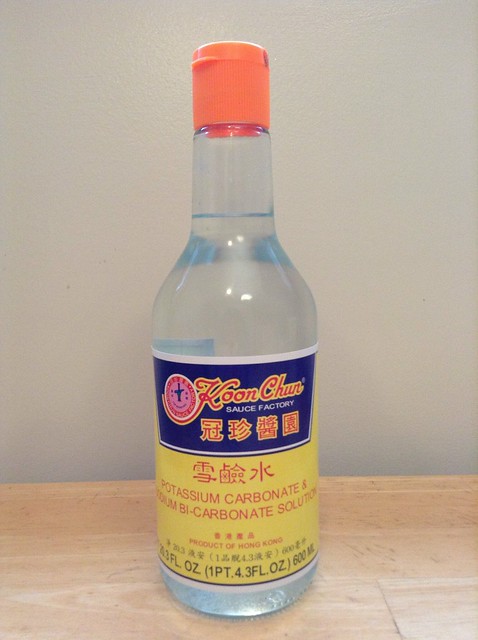
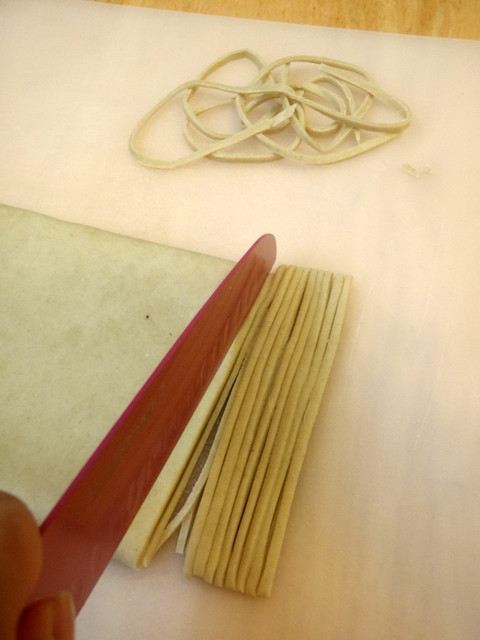

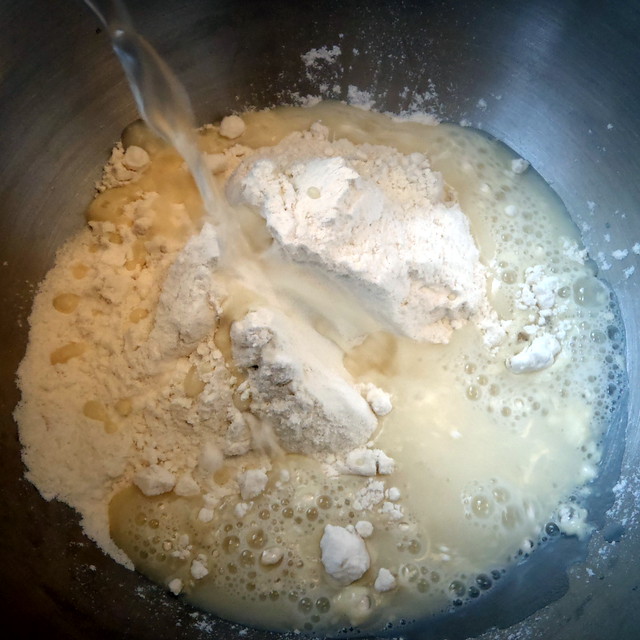


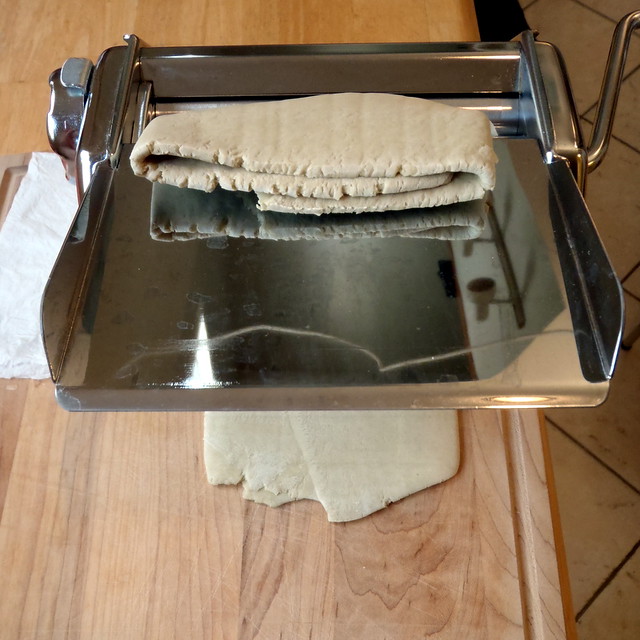
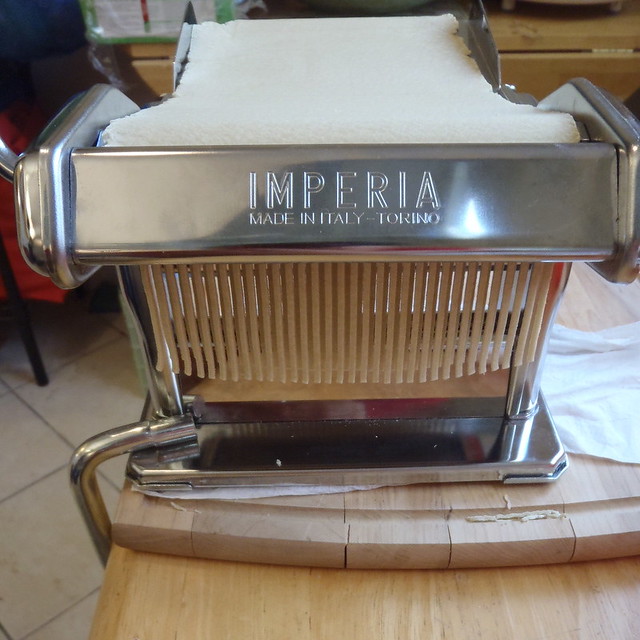
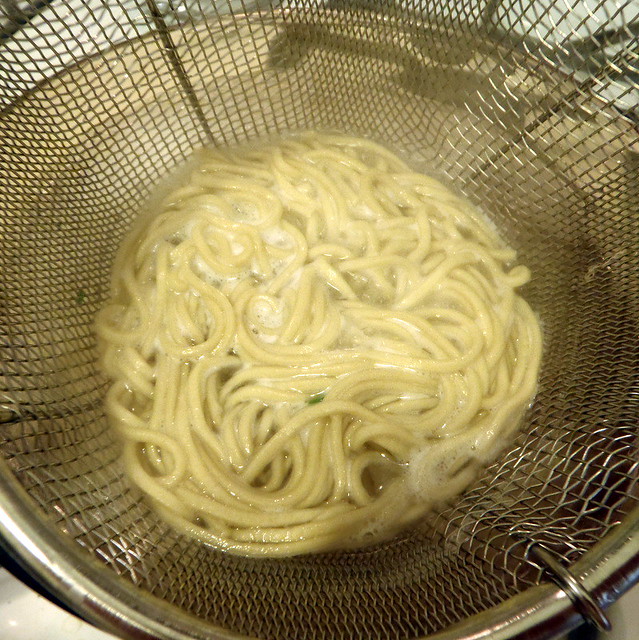





I absolutely love your blog! So glad you are back!
ReplyDeleteThanks!
DeleteCan you make me some whole wheat ramen? :)
ReplyDeleteOoh, I'll try it and see if it works!
DeleteYou really don't want the bran and germ of the grains present for chewy things (noodles, bagels, pretzels...) The germ contains lipids, and the bran has a lot of fiber (presumably why you want it included) which breaks up gluten strands and destroys chewy texture. Whole wheat does well as a percentage of a bread's flours because breads are generally soft and don't rely too heavily on long gluten strands.
DeleteI really love ramen noodles. Everytime I go to a Japanese restaurant, I immediately order ramen. :)
ReplyDelete- MiracleNoodle.com
I cannot WAiT to try this. I love noodles but avoid them because of the many many many unhealthy ingredients used in the mass produced ones.
ReplyDeleteLet me know how it turns out!
DeleteWhich unhealthy ingredients? Mass-produced noodles are generally just starch and gluten and oil (from frying). Most will contain some sort of polysaccharide for texture that sounds very scary and unpronounceable on the label but is no more harmful than amylose and amylopectin (starch!). Preservatives, which are perhaps the most suspect, round out the list, but have all been approved by the FDA if you're buying your noodles in the States.
DeleteRegarding health, the worst part is the oil and the high-glycemic-index starch. The starch will be identical in your homemade version, so I think just the frying part is different at home?
Let us know which unhealthy ingredients you mean.
Exactly why she should be worried. Its FDA approved just like HFCS, Aspartame, GMO's and many other disgustingly bad for you items that they got big pay days to let through as "SAFE"
DeleteI would think the only way to get them to be curly would be to zigzag them as you lay them down and let naturally dehydrate a little to get the shape of the curves to set. In theory when they're added back to the broth and become a little more reconstituted, they should still have some wiggly resemblance left. I only came to this conclusion through natural deduction. The reason instant ramen is squiggly like it is lies in the fact that it's really thin noodles blasted out like silly string and then left like that in a dried state, until the consumer takes it home to prepare.
ReplyDeleteI've also never had really squiggly noodles in any of the ramen shops i've frequented and I guess that's inherent to the fact GOOD noodles aren't mass produced in machines and immediately fried in convenient little boxes. Whoulda thought?
DeleteI like cooking my noodles in the Rapid Ramen Cooker. Check it out! www.RapidRamen.com
ReplyDeleteAmazing! I'd loe to make my own ramen noodles, too. Thanks for sharing this recipe! :)
ReplyDeleteU don't rest ur dough?
ReplyDeleteI do; after rolling it through the pasta machine a few times until the dough is smoother, I wrap it and rest it overnight in the fridge.
DeleteCurly is a product of how the noodles are formed then laid to dry, I have played around with it some making them really thin and laying them on a wavy surface to dry works ok but factories use fast working air dryers to dry the noodle with the wavy vented drying mat then noodles are over laid something that is almost impossible to do at home.
ReplyDeleteNot impossible to make curly noodles at home. Watch how Alton Brown makes homemade jerky with a box fan and air filters... This would result in a faster dry for the noodles, and if you placed bakers racks on the filters and then placed the noodles on the racks, pretty sure you would get a great wiggle wave in your dry noodles :D
ReplyDelete